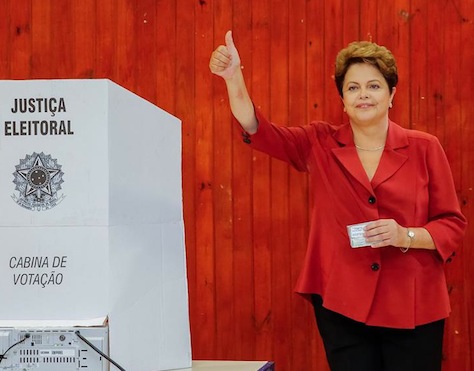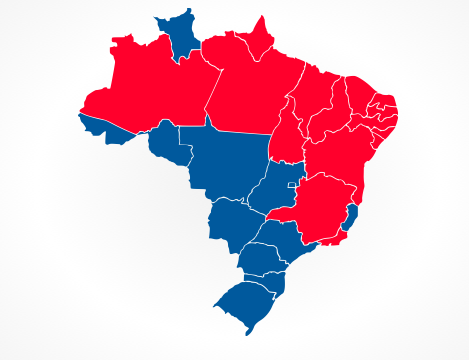It was the closest presidential race since the end of Brazil’s military dictatorship in 1985.![]()
Ultimately, the benefits of incumbency and the track record of poverty reduction were enough to push Dilma Rousseff to reelection against an alliance between her center-right opponent, Aécio Neves, and former candidate Marina Silva, who finished third in the October 5 first-round vote.
Rousseff narrowly defeated Neves by a margin of 51.52% to 48.38% in Sunday’s vote, giving the center-left Partido dos Trabalhadores (PT, Workers Party) a fourth consecutive term in power.
Neves, the candidate of the Partido da Social Democracia Brasileira (PSDB, Brazilian Social Democracy Party), came from behind to win a spot in the runoff after Silva’s candidacy imploded earlier this year. Silva, a former environmental minister who assumed the presidential nomination of the Partido Socialista Brasileiro (PSB, Brazilian Socialist Party), after its initial candidate, former Pernambuco governor Eduardo Campos, died in an airplane crash in mid-August.
Neves, who served as a highly regarded governor of Minas Gerais, Brazil’s second-most populous state, from 2002 to 2010, is a member of the Brazilian Senado (Senate), and he challenged Rousseff aggressively for several high-profile corruption cases, most recently revelations of kickbacks to PT politicians and their allies from Petrobras, the state-owned oil company.
* * * * *
RELATED: Petrobras scandal highlights 12 years of Brazilian corruption
* * * * *
The electorate predictably split between the PT’s supporters in the relatively poorer northeast and the PSDB’s more conservative base in the relatively wealthier southeast. Rousseff narrowly won the crucial battlegrounds of Rio de Janeiro and Minas Gerais, though the PT’s support dropped sharply from its levels in the 2002, 2006 and 2010 elections.
Nevertheless, Rousseff’s PT-led coalition will enjoy a large congressional majority. Voters chose all 513 members of the lower house of the Brazilian congress, the Câmara dos Deputados (Chamber of Deputies) in the October 5 round.
That’s notwithstanding moderate losses for the PT and its largest partner, the ideologically vapid Partido do Movimento Democrático Brasileiro (Brazilian Democratic Movement Party, PMDB), largely at the hands of the Partido Social Democrático (PSD, Social Democratic Party), a party formed in 2011 by former São Paulo mayor Gilberto Kassab and a handful of PSDB and other centrist dissenters, who are also part of Rousseff’s coalition.
So what does Rousseff’s reelection mean for Brazil and for the wider Latin American region?
Watch for Dilma to change economic course in rapid order.
Though Brazil’s economic downturn wasn’t quite harsh enough to prevent Rousseff’s reelection, greater economic pain is coming. GDP growth is far below the levels that Brazil enjoyed under former president Luiz Inácio Lula da Silva between 2002 and 2010 and earlier in Rousseff’s administration. Inflation is approaching the unsustainable level of 7%, commodities prices are falling in the global economy, and Brazil’s currency has lost significant value this year. Moreover, the investor class lost much of its confidence in Rousseff’s government, explaining why the Brazilian real dropped 0.5% in value against the US dollar earlier this week, as polls showed that Rousseff’s reelection increasingly likely.
Nevertheless, Brazil’s economic policy seemed headed for a revamp no matter the outcome of today’s vote. Rousseff is widely expected to sack finance minister Guido Mantega, who has held the office since 2006. She will almost certainly have to cut Brazil’s budget as a likely recession reduces government revenues. Tough steps to curb inflation will exacerbate economic misery in the short term, but if her government takes a less interventionist role in propping up Brazil’s currency, it could nevertheless boost the country’s exports and make it a cheaper tourist destination for Americans and Europeans two years before Rio de Janeiro hosts the 2016 Summer Olympics.
No significant changes to Brazil’s regional foreign policy.
Washington must be disappointed tonight, because a Neves presidency would have meant a greater emphasis on foreign trade, including the slight possibility of a return to a ‘Free Trade of the Americas Agreement’ that the last PSDB administration championed.
Neves, who might easily have appointed the charismatic and well-known Silva as his foreign minister, would not have cut Brasília’s ties to Venezuela, Cuba and other US foes across the region. But there’s no doubt that Neves would have moved gingerly closer to the United States and away from some of Latin America’s most controversial socialist regimes. He would have also reset relations with Washington after Rousseff canceled a state dinner in the aftermath of revelations of widespread intelligence gathering by the US National Security Agency.
Rousseff will be hesitant to distance Brazil from Havana or Caracas or from the other BRIC countries with which Brazil has deepened ties over the past four years, including Russian president Vladimir Putin and Chinese president Xi Jinping.
A Lula return in 2018?
The final days of the campaign were notable for the re-emergence of Lula da Silva on the campaign trail. It’s not an overstatement that he is quite possibly Latin America’s most popular political figure, to say nothing of Brazil, where he is adored as a leader who created many social welfare programs to boost health care, education, clean water, housing and other vectors, virtually eliminated extreme poverty. That includes, of course, his flagship Bolsa Familia, the program that provides cash handouts to Brazil’s poorest families.
The lulista emphasis on social welfare is probably the reason why Rousseff won reelection, and she effectively scared many voters away from backing first Silva, then Neves, through harsh negative campaigning that warned both Silva and Neves would eliminate the gains of the past 12 years for Brazil’s poor and emerging middle class. Those warnings were always overstated, but they were powerful nonetheless.
That’s why there’s been so much talk of Lula da Silva returning to run for the presidency again in 2018, when Rousseff’s second term ends. Even If Rousseff, now a lame-duck president, fails to lead Brazil’s economy back to steady growth, Lula da Silva will be able to run in 2018 by distancing himself from Rousseff’s economic policy and focusing attention on the success of his prior administration.
Nevertheless, Lula da Silva currently enjoys the status of a global rock star, and his legacy seems secure. Why risk that with the possibility of a disappointing comeback? Lula will also be 72 years old in 2018, running in what would be his sixth presidential election since 1989. Even if Lula da Silva has the stamina for that race, there’s no guarantee that voters would see him as the best vessel for leading Brazil into the 2020s.
Still, until he makes a definitive decision on a 2018 race, Lula da Silva will color the future of Brazilian politics just as Hillary Clinton, the presumed frontrunner for the 2016 Democratic presidential nomination, hovers over the future of US politics.
Aécio Neves will have a second chance, Marina Silva might not.
Neves, who was first elected to the Senate in 2010, won’t be up for reelection until 2018, when he will be the frontrunner to win the PSDB presidential nomination again.
It took Lula da Silva four tries to win the Brazilian presidency, and Marina Silva, despite her disappointing first-round finish, has now run for president twice. Moreover, the PSDB gave José Serra, the former mayor of São Paulo and the former governor of São Paulo state, two chances at the presidency — in 2002 against Lula da Silva and again in 2010 against Rousseff.
Although he narrowly lost his home state of Minas Gerais (by what must be a disappointing margin of 52.4% to 47.6%), Neves remains incredibly popular in his home state. São Paulo, Brazil’s most populous state, is a PSDB stronghold that has produced every PSDB candidate in the post-dictatorship era. In contrast, Minas Gerais has been much more fertile territory for the PT, which won nearly 58.5% in 2010. Though Neves narrowed Rousseff’s margin, he almost certainly had to win his home state to have any chance at winning the presidency in 2014. But his lingering popularity will benefit any future presidential bid, especially if Lula da Silva declines to run.
A comeback may be trickier for Silva, who only recently joined the PSB as Campos’s running mate when she failed to register her own political party, the Rede Sustentabilidade (Sustainability Network).
Though she led polls against Rousseff throughout September, her campaign collapsed in its final days under the pressure of Rousseff’s vastly superior resources.
* * * * *
RELATED: Five reasons why one-time frontrunner Silva tanked
* * * * *
Silva and the PSB were always uncomfortable allies, but the party provided her much more institutional machinery than she would have been able to muster on her own. Paulo Câmara easily won the Pernambuco gubernatorial race in the first round, and Rodrigo Rollemberg won the governorship of the Distrito Federal (Federal District) in Sunday’s runoff.



One thought on “Brazil election results: What to expect from Dilma’s second term”